Impact of Extracurricular Activities on Employee Productivity: A Case Study of Hyatt Regency Sydney
VerifiedAdded on 2023/06/04
|15
|2960
|116
AI Summary
This study examines the impact of extracurricular activities on the productivity of employees at Hyatt Regency Sydney. It explores the significance of extracurricular activities at work on the performance of employees across different industries. The study utilizes a mixed design to accomplish a mixture of different methods which will general overall results of the statistical analysis. The objective of this research is to assess the impacts of extracurricular activities on employee productivity, a case study of Hyatt Regency Sydney.
Contribute Materials
Your contribution can guide someone’s learning journey. Share your
documents today.
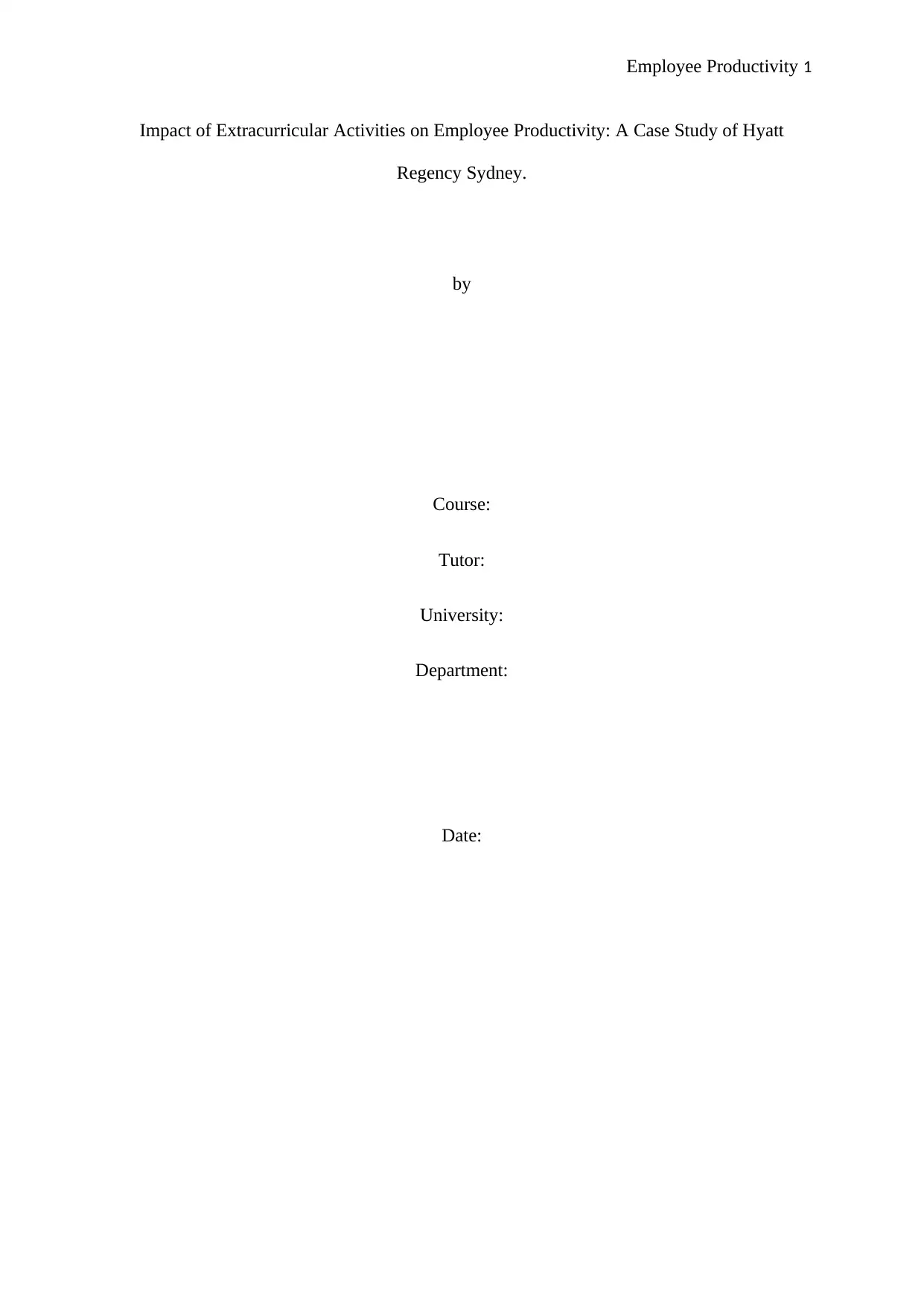
Employee Productivity 1
Impact of Extracurricular Activities on Employee Productivity: A Case Study of Hyatt
Regency Sydney.
by
Course:
Tutor:
University:
Department:
Date:
Impact of Extracurricular Activities on Employee Productivity: A Case Study of Hyatt
Regency Sydney.
by
Course:
Tutor:
University:
Department:
Date:
Secure Best Marks with AI Grader
Need help grading? Try our AI Grader for instant feedback on your assignments.
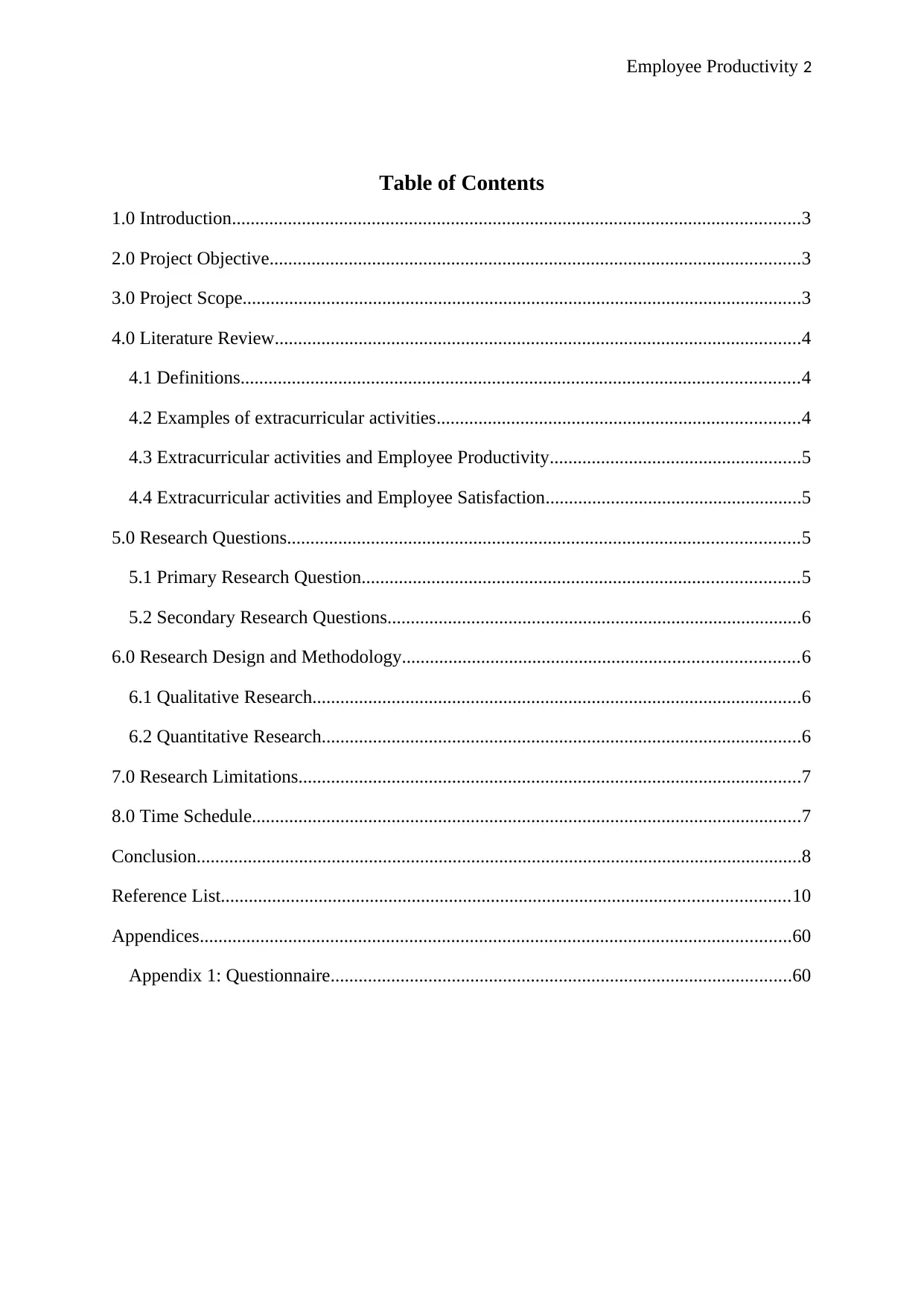
Employee Productivity 2
Table of Contents
1.0 Introduction..........................................................................................................................3
2.0 Project Objective..................................................................................................................3
3.0 Project Scope........................................................................................................................3
4.0 Literature Review.................................................................................................................4
4.1 Definitions........................................................................................................................4
4.2 Examples of extracurricular activities..............................................................................4
4.3 Extracurricular activities and Employee Productivity......................................................5
4.4 Extracurricular activities and Employee Satisfaction.......................................................5
5.0 Research Questions..............................................................................................................5
5.1 Primary Research Question..............................................................................................5
5.2 Secondary Research Questions.........................................................................................6
6.0 Research Design and Methodology.....................................................................................6
6.1 Qualitative Research.........................................................................................................6
6.2 Quantitative Research.......................................................................................................6
7.0 Research Limitations............................................................................................................7
8.0 Time Schedule......................................................................................................................7
Conclusion..................................................................................................................................8
Reference List..........................................................................................................................10
Appendices...............................................................................................................................60
Appendix 1: Questionnaire...................................................................................................60
Table of Contents
1.0 Introduction..........................................................................................................................3
2.0 Project Objective..................................................................................................................3
3.0 Project Scope........................................................................................................................3
4.0 Literature Review.................................................................................................................4
4.1 Definitions........................................................................................................................4
4.2 Examples of extracurricular activities..............................................................................4
4.3 Extracurricular activities and Employee Productivity......................................................5
4.4 Extracurricular activities and Employee Satisfaction.......................................................5
5.0 Research Questions..............................................................................................................5
5.1 Primary Research Question..............................................................................................5
5.2 Secondary Research Questions.........................................................................................6
6.0 Research Design and Methodology.....................................................................................6
6.1 Qualitative Research.........................................................................................................6
6.2 Quantitative Research.......................................................................................................6
7.0 Research Limitations............................................................................................................7
8.0 Time Schedule......................................................................................................................7
Conclusion..................................................................................................................................8
Reference List..........................................................................................................................10
Appendices...............................................................................................................................60
Appendix 1: Questionnaire...................................................................................................60
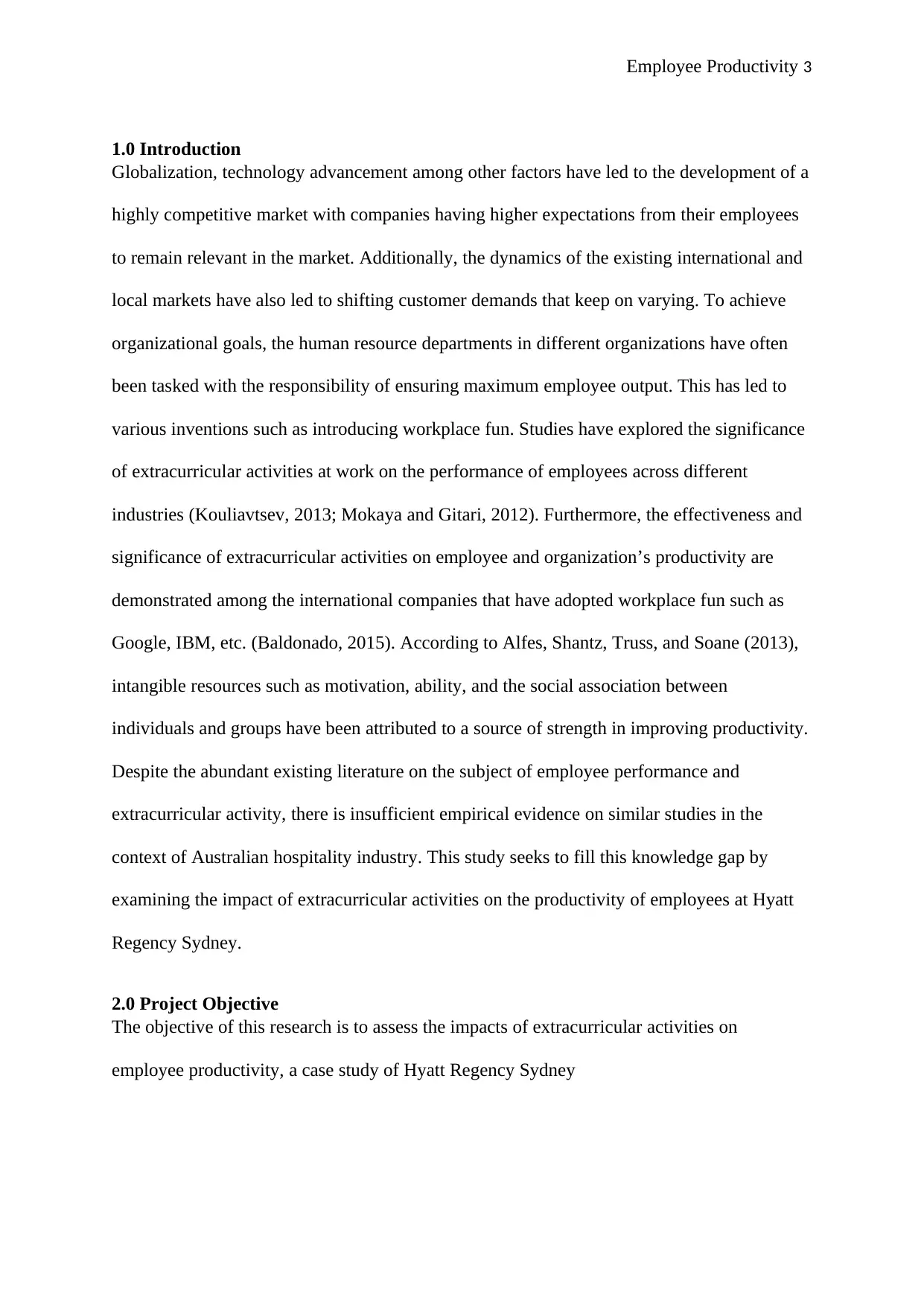
Employee Productivity 3
1.0 Introduction
Globalization, technology advancement among other factors have led to the development of a
highly competitive market with companies having higher expectations from their employees
to remain relevant in the market. Additionally, the dynamics of the existing international and
local markets have also led to shifting customer demands that keep on varying. To achieve
organizational goals, the human resource departments in different organizations have often
been tasked with the responsibility of ensuring maximum employee output. This has led to
various inventions such as introducing workplace fun. Studies have explored the significance
of extracurricular activities at work on the performance of employees across different
industries (Kouliavtsev, 2013; Mokaya and Gitari, 2012). Furthermore, the effectiveness and
significance of extracurricular activities on employee and organization’s productivity are
demonstrated among the international companies that have adopted workplace fun such as
Google, IBM, etc. (Baldonado, 2015). According to Alfes, Shantz, Truss, and Soane (2013),
intangible resources such as motivation, ability, and the social association between
individuals and groups have been attributed to a source of strength in improving productivity.
Despite the abundant existing literature on the subject of employee performance and
extracurricular activity, there is insufficient empirical evidence on similar studies in the
context of Australian hospitality industry. This study seeks to fill this knowledge gap by
examining the impact of extracurricular activities on the productivity of employees at Hyatt
Regency Sydney.
2.0 Project Objective
The objective of this research is to assess the impacts of extracurricular activities on
employee productivity, a case study of Hyatt Regency Sydney
1.0 Introduction
Globalization, technology advancement among other factors have led to the development of a
highly competitive market with companies having higher expectations from their employees
to remain relevant in the market. Additionally, the dynamics of the existing international and
local markets have also led to shifting customer demands that keep on varying. To achieve
organizational goals, the human resource departments in different organizations have often
been tasked with the responsibility of ensuring maximum employee output. This has led to
various inventions such as introducing workplace fun. Studies have explored the significance
of extracurricular activities at work on the performance of employees across different
industries (Kouliavtsev, 2013; Mokaya and Gitari, 2012). Furthermore, the effectiveness and
significance of extracurricular activities on employee and organization’s productivity are
demonstrated among the international companies that have adopted workplace fun such as
Google, IBM, etc. (Baldonado, 2015). According to Alfes, Shantz, Truss, and Soane (2013),
intangible resources such as motivation, ability, and the social association between
individuals and groups have been attributed to a source of strength in improving productivity.
Despite the abundant existing literature on the subject of employee performance and
extracurricular activity, there is insufficient empirical evidence on similar studies in the
context of Australian hospitality industry. This study seeks to fill this knowledge gap by
examining the impact of extracurricular activities on the productivity of employees at Hyatt
Regency Sydney.
2.0 Project Objective
The objective of this research is to assess the impacts of extracurricular activities on
employee productivity, a case study of Hyatt Regency Sydney
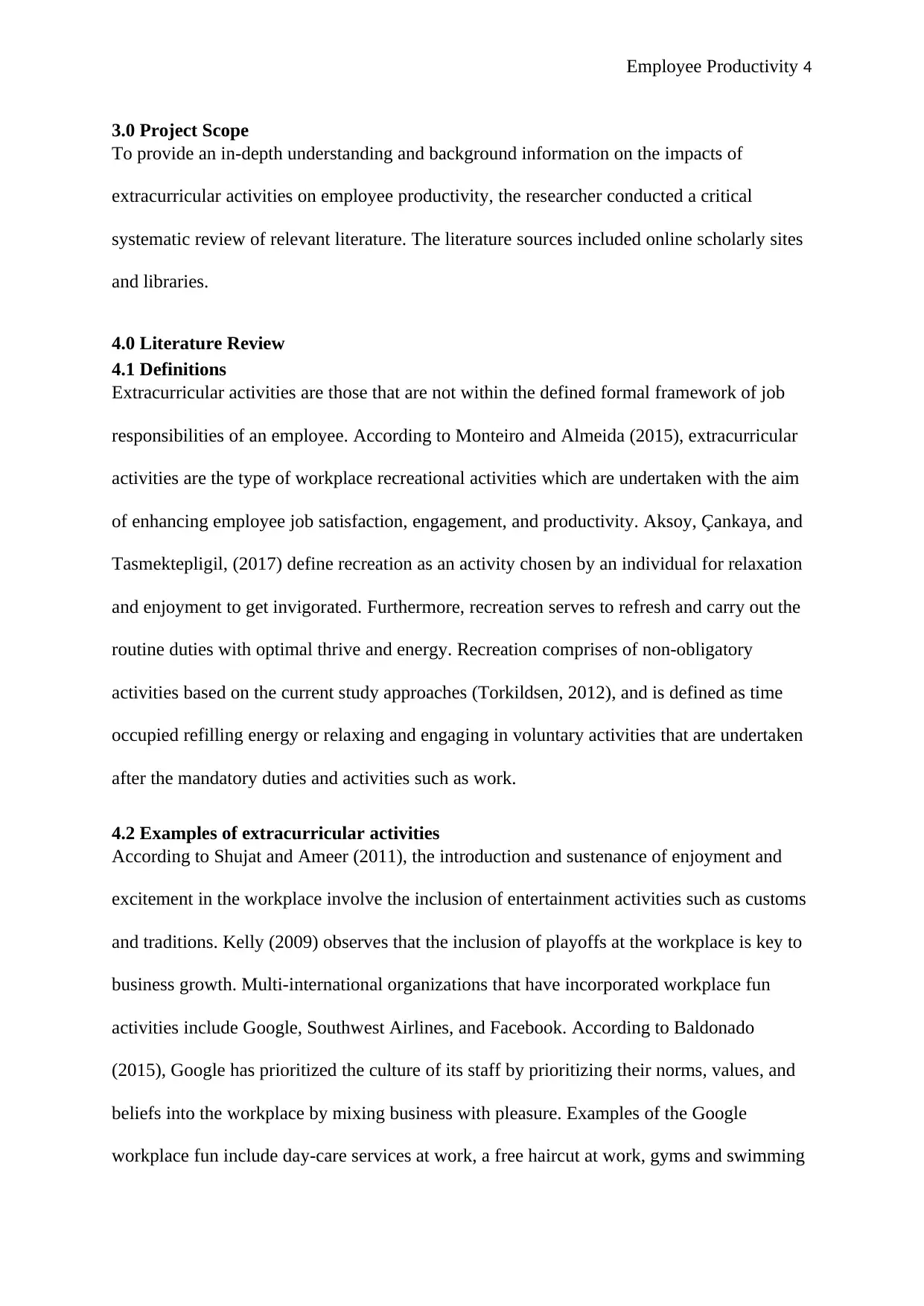
Employee Productivity 4
3.0 Project Scope
To provide an in-depth understanding and background information on the impacts of
extracurricular activities on employee productivity, the researcher conducted a critical
systematic review of relevant literature. The literature sources included online scholarly sites
and libraries.
4.0 Literature Review
4.1 Definitions
Extracurricular activities are those that are not within the defined formal framework of job
responsibilities of an employee. According to Monteiro and Almeida (2015), extracurricular
activities are the type of workplace recreational activities which are undertaken with the aim
of enhancing employee job satisfaction, engagement, and productivity. Aksoy, Çankaya, and
Tasmektepligil, (2017) define recreation as an activity chosen by an individual for relaxation
and enjoyment to get invigorated. Furthermore, recreation serves to refresh and carry out the
routine duties with optimal thrive and energy. Recreation comprises of non-obligatory
activities based on the current study approaches (Torkildsen, 2012), and is defined as time
occupied refilling energy or relaxing and engaging in voluntary activities that are undertaken
after the mandatory duties and activities such as work.
4.2 Examples of extracurricular activities
According to Shujat and Ameer (2011), the introduction and sustenance of enjoyment and
excitement in the workplace involve the inclusion of entertainment activities such as customs
and traditions. Kelly (2009) observes that the inclusion of playoffs at the workplace is key to
business growth. Multi-international organizations that have incorporated workplace fun
activities include Google, Southwest Airlines, and Facebook. According to Baldonado
(2015), Google has prioritized the culture of its staff by prioritizing their norms, values, and
beliefs into the workplace by mixing business with pleasure. Examples of the Google
workplace fun include day-care services at work, a free haircut at work, gyms and swimming
3.0 Project Scope
To provide an in-depth understanding and background information on the impacts of
extracurricular activities on employee productivity, the researcher conducted a critical
systematic review of relevant literature. The literature sources included online scholarly sites
and libraries.
4.0 Literature Review
4.1 Definitions
Extracurricular activities are those that are not within the defined formal framework of job
responsibilities of an employee. According to Monteiro and Almeida (2015), extracurricular
activities are the type of workplace recreational activities which are undertaken with the aim
of enhancing employee job satisfaction, engagement, and productivity. Aksoy, Çankaya, and
Tasmektepligil, (2017) define recreation as an activity chosen by an individual for relaxation
and enjoyment to get invigorated. Furthermore, recreation serves to refresh and carry out the
routine duties with optimal thrive and energy. Recreation comprises of non-obligatory
activities based on the current study approaches (Torkildsen, 2012), and is defined as time
occupied refilling energy or relaxing and engaging in voluntary activities that are undertaken
after the mandatory duties and activities such as work.
4.2 Examples of extracurricular activities
According to Shujat and Ameer (2011), the introduction and sustenance of enjoyment and
excitement in the workplace involve the inclusion of entertainment activities such as customs
and traditions. Kelly (2009) observes that the inclusion of playoffs at the workplace is key to
business growth. Multi-international organizations that have incorporated workplace fun
activities include Google, Southwest Airlines, and Facebook. According to Baldonado
(2015), Google has prioritized the culture of its staff by prioritizing their norms, values, and
beliefs into the workplace by mixing business with pleasure. Examples of the Google
workplace fun include day-care services at work, a free haircut at work, gyms and swimming
Secure Best Marks with AI Grader
Need help grading? Try our AI Grader for instant feedback on your assignments.
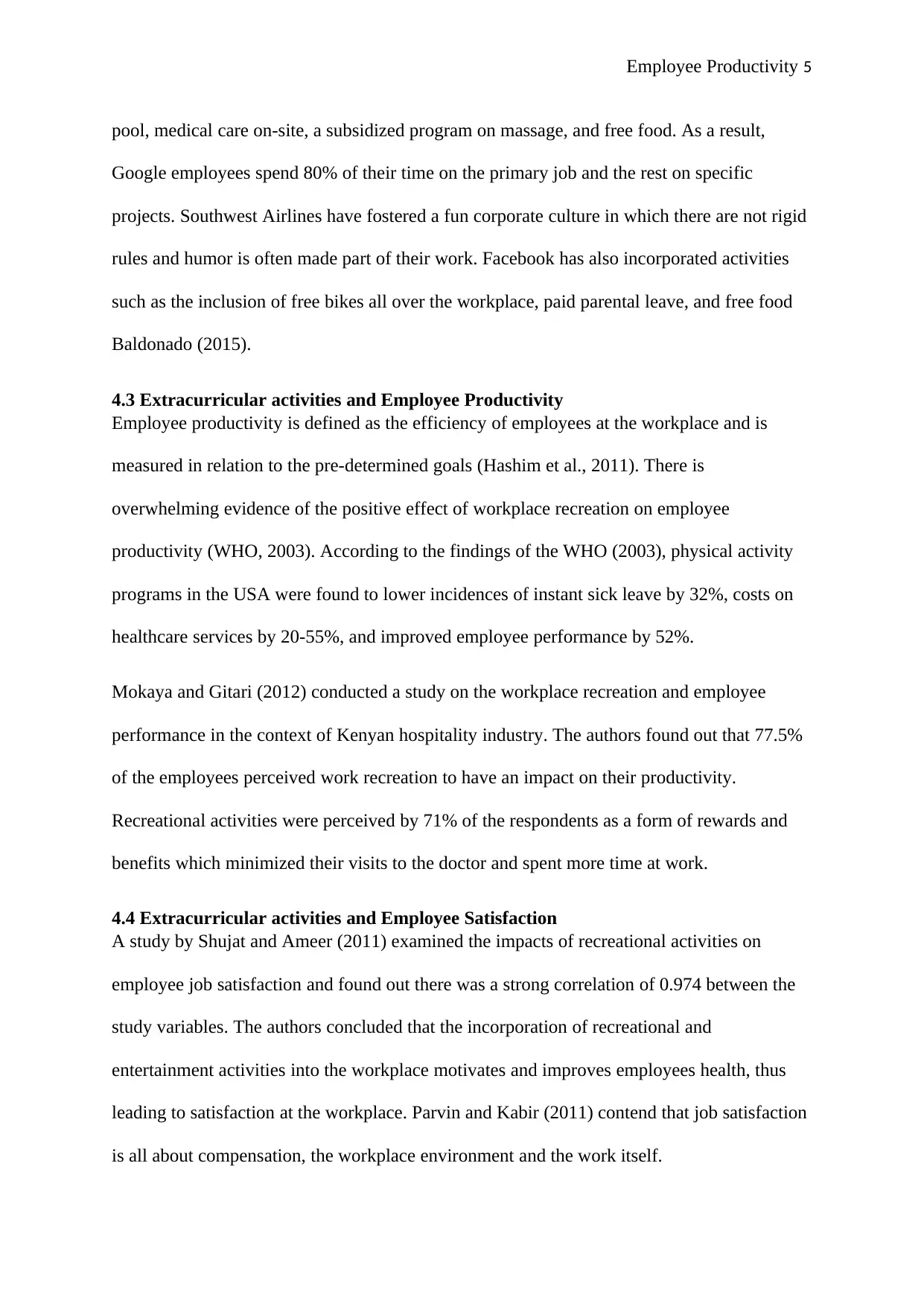
Employee Productivity 5
pool, medical care on-site, a subsidized program on massage, and free food. As a result,
Google employees spend 80% of their time on the primary job and the rest on specific
projects. Southwest Airlines have fostered a fun corporate culture in which there are not rigid
rules and humor is often made part of their work. Facebook has also incorporated activities
such as the inclusion of free bikes all over the workplace, paid parental leave, and free food
Baldonado (2015).
4.3 Extracurricular activities and Employee Productivity
Employee productivity is defined as the efficiency of employees at the workplace and is
measured in relation to the pre-determined goals (Hashim et al., 2011). There is
overwhelming evidence of the positive effect of workplace recreation on employee
productivity (WHO, 2003). According to the findings of the WHO (2003), physical activity
programs in the USA were found to lower incidences of instant sick leave by 32%, costs on
healthcare services by 20-55%, and improved employee performance by 52%.
Mokaya and Gitari (2012) conducted a study on the workplace recreation and employee
performance in the context of Kenyan hospitality industry. The authors found out that 77.5%
of the employees perceived work recreation to have an impact on their productivity.
Recreational activities were perceived by 71% of the respondents as a form of rewards and
benefits which minimized their visits to the doctor and spent more time at work.
4.4 Extracurricular activities and Employee Satisfaction
A study by Shujat and Ameer (2011) examined the impacts of recreational activities on
employee job satisfaction and found out there was a strong correlation of 0.974 between the
study variables. The authors concluded that the incorporation of recreational and
entertainment activities into the workplace motivates and improves employees health, thus
leading to satisfaction at the workplace. Parvin and Kabir (2011) contend that job satisfaction
is all about compensation, the workplace environment and the work itself.
pool, medical care on-site, a subsidized program on massage, and free food. As a result,
Google employees spend 80% of their time on the primary job and the rest on specific
projects. Southwest Airlines have fostered a fun corporate culture in which there are not rigid
rules and humor is often made part of their work. Facebook has also incorporated activities
such as the inclusion of free bikes all over the workplace, paid parental leave, and free food
Baldonado (2015).
4.3 Extracurricular activities and Employee Productivity
Employee productivity is defined as the efficiency of employees at the workplace and is
measured in relation to the pre-determined goals (Hashim et al., 2011). There is
overwhelming evidence of the positive effect of workplace recreation on employee
productivity (WHO, 2003). According to the findings of the WHO (2003), physical activity
programs in the USA were found to lower incidences of instant sick leave by 32%, costs on
healthcare services by 20-55%, and improved employee performance by 52%.
Mokaya and Gitari (2012) conducted a study on the workplace recreation and employee
performance in the context of Kenyan hospitality industry. The authors found out that 77.5%
of the employees perceived work recreation to have an impact on their productivity.
Recreational activities were perceived by 71% of the respondents as a form of rewards and
benefits which minimized their visits to the doctor and spent more time at work.
4.4 Extracurricular activities and Employee Satisfaction
A study by Shujat and Ameer (2011) examined the impacts of recreational activities on
employee job satisfaction and found out there was a strong correlation of 0.974 between the
study variables. The authors concluded that the incorporation of recreational and
entertainment activities into the workplace motivates and improves employees health, thus
leading to satisfaction at the workplace. Parvin and Kabir (2011) contend that job satisfaction
is all about compensation, the workplace environment and the work itself.

Employee Productivity 6
5.0 Research Questions
5.1 Primary Research Question
1. What is the impact of extracurricular activities on employee productivity at Hyatt
Regency Sydney?
5.2 Secondary Research Questions
1. How do extracurricular activities affect employee productivity at Hyatt Regency
Sydney?
2. What is the association between extracurricular activities and job satisfaction and
employee productivity?
6.0 Research Design and Methodology
The study will utilize a mixed design to accomplish a mixture of different methods which
will general overall results of the statistical analysis (Maxwell, 2012).
6.1 Qualitative Research
The researcher gathered qualitative data of existing relevant literature to provide an
comprehensive understanding of the study topic. Research questions were first generated
through undertaking a critical review of existing relevant literature. A sample of 50
employees of Hyatt Regency, Sydney will be randomly selected for inclusion. The study will
adopt a purposive sampling design to ensure that only participant rich with information are
included in the study within the least time possible (Etikan, Musa, and Alkassim, 2016). A
semi-structured interview designed by the researcher will be used to collect data because it
fosters two-way communication and is less intrusive to the interviewee (Rabionet, 2011). A
tape recording will be used to capture the proceedings of the interview and then analyzed
later using thematic analysis guided by the study objectives.
The retrieval of the tape recording will be done by another expert to ensure consistent and
transparent interpretation of data (Noble and Smith, 2015). This will also ensure that
5.0 Research Questions
5.1 Primary Research Question
1. What is the impact of extracurricular activities on employee productivity at Hyatt
Regency Sydney?
5.2 Secondary Research Questions
1. How do extracurricular activities affect employee productivity at Hyatt Regency
Sydney?
2. What is the association between extracurricular activities and job satisfaction and
employee productivity?
6.0 Research Design and Methodology
The study will utilize a mixed design to accomplish a mixture of different methods which
will general overall results of the statistical analysis (Maxwell, 2012).
6.1 Qualitative Research
The researcher gathered qualitative data of existing relevant literature to provide an
comprehensive understanding of the study topic. Research questions were first generated
through undertaking a critical review of existing relevant literature. A sample of 50
employees of Hyatt Regency, Sydney will be randomly selected for inclusion. The study will
adopt a purposive sampling design to ensure that only participant rich with information are
included in the study within the least time possible (Etikan, Musa, and Alkassim, 2016). A
semi-structured interview designed by the researcher will be used to collect data because it
fosters two-way communication and is less intrusive to the interviewee (Rabionet, 2011). A
tape recording will be used to capture the proceedings of the interview and then analyzed
later using thematic analysis guided by the study objectives.
The retrieval of the tape recording will be done by another expert to ensure consistent and
transparent interpretation of data (Noble and Smith, 2015). This will also ensure that
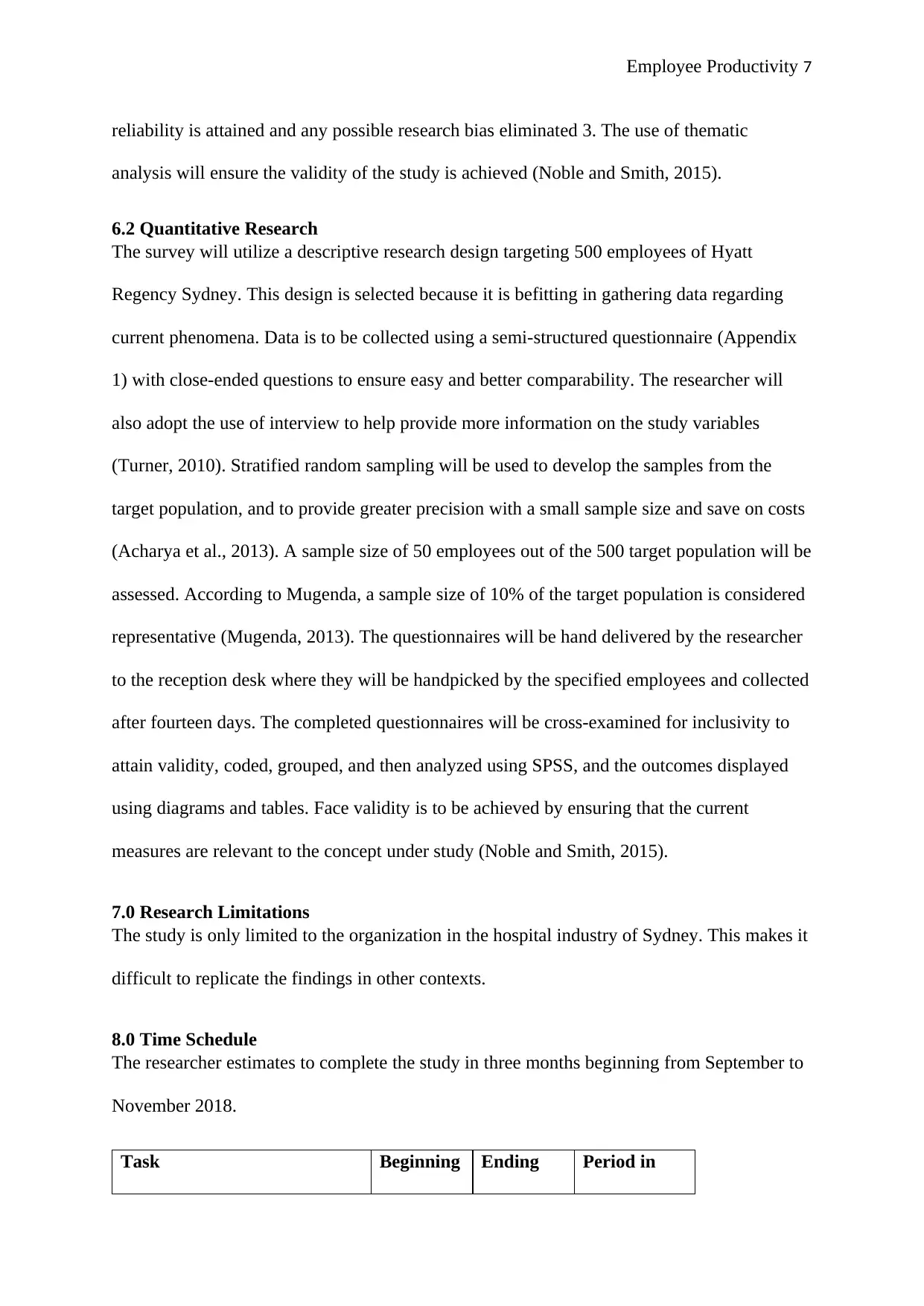
Employee Productivity 7
reliability is attained and any possible research bias eliminated 3. The use of thematic
analysis will ensure the validity of the study is achieved (Noble and Smith, 2015).
6.2 Quantitative Research
The survey will utilize a descriptive research design targeting 500 employees of Hyatt
Regency Sydney. This design is selected because it is befitting in gathering data regarding
current phenomena. Data is to be collected using a semi-structured questionnaire (Appendix
1) with close-ended questions to ensure easy and better comparability. The researcher will
also adopt the use of interview to help provide more information on the study variables
(Turner, 2010). Stratified random sampling will be used to develop the samples from the
target population, and to provide greater precision with a small sample size and save on costs
(Acharya et al., 2013). A sample size of 50 employees out of the 500 target population will be
assessed. According to Mugenda, a sample size of 10% of the target population is considered
representative (Mugenda, 2013). The questionnaires will be hand delivered by the researcher
to the reception desk where they will be handpicked by the specified employees and collected
after fourteen days. The completed questionnaires will be cross-examined for inclusivity to
attain validity, coded, grouped, and then analyzed using SPSS, and the outcomes displayed
using diagrams and tables. Face validity is to be achieved by ensuring that the current
measures are relevant to the concept under study (Noble and Smith, 2015).
7.0 Research Limitations
The study is only limited to the organization in the hospital industry of Sydney. This makes it
difficult to replicate the findings in other contexts.
8.0 Time Schedule
The researcher estimates to complete the study in three months beginning from September to
November 2018.
Task Beginning Ending Period in
reliability is attained and any possible research bias eliminated 3. The use of thematic
analysis will ensure the validity of the study is achieved (Noble and Smith, 2015).
6.2 Quantitative Research
The survey will utilize a descriptive research design targeting 500 employees of Hyatt
Regency Sydney. This design is selected because it is befitting in gathering data regarding
current phenomena. Data is to be collected using a semi-structured questionnaire (Appendix
1) with close-ended questions to ensure easy and better comparability. The researcher will
also adopt the use of interview to help provide more information on the study variables
(Turner, 2010). Stratified random sampling will be used to develop the samples from the
target population, and to provide greater precision with a small sample size and save on costs
(Acharya et al., 2013). A sample size of 50 employees out of the 500 target population will be
assessed. According to Mugenda, a sample size of 10% of the target population is considered
representative (Mugenda, 2013). The questionnaires will be hand delivered by the researcher
to the reception desk where they will be handpicked by the specified employees and collected
after fourteen days. The completed questionnaires will be cross-examined for inclusivity to
attain validity, coded, grouped, and then analyzed using SPSS, and the outcomes displayed
using diagrams and tables. Face validity is to be achieved by ensuring that the current
measures are relevant to the concept under study (Noble and Smith, 2015).
7.0 Research Limitations
The study is only limited to the organization in the hospital industry of Sydney. This makes it
difficult to replicate the findings in other contexts.
8.0 Time Schedule
The researcher estimates to complete the study in three months beginning from September to
November 2018.
Task Beginning Ending Period in
Paraphrase This Document
Need a fresh take? Get an instant paraphrase of this document with our AI Paraphraser

Employee Productivity 8
Date Date Days
Choice of Study topic 04/09/2018 12/09/2018 8
Formulation of research
objectives and questions
13/09/2018 18/09/2018 5
Data collection method 20/09/2018 24/09/2018 4
Design of Questionnaire 20/09/2018 24/09/2018 4
Organization of project
proposal
25/09/2018 03/10/2018 8
Determination of sample size 08/10/2018 15/10/2018 7
Gathering Data
Secondary Data 18/10/2018 24/10/2018 6
Primary Data 26/10/2018 02/11/2018 7
Data Analysis 04/11/2018 12/11/2018 8
Report writing 15/11/2018 22/11/2018 7
Final Submission of Report 25/11/2018 28/11/2018 3
Total Number of Days 67
Conclusion
The effect of extracurricular activities on the productivity of employees has received much
attention due to the changes in the consumer market that have led to stiff competition. To
meet the needs of the consumers in a dynamic and globalized market, most of the
organizations that have resorted to the introduction of extracurricular activities at the
workplace have grown to become multi-international companies. Extracurricular activities at
the workplace such as gyms, swimming pools, barber shops, free meals, and sports activities,
among others have been associated with improved employee productivity and job
Date Date Days
Choice of Study topic 04/09/2018 12/09/2018 8
Formulation of research
objectives and questions
13/09/2018 18/09/2018 5
Data collection method 20/09/2018 24/09/2018 4
Design of Questionnaire 20/09/2018 24/09/2018 4
Organization of project
proposal
25/09/2018 03/10/2018 8
Determination of sample size 08/10/2018 15/10/2018 7
Gathering Data
Secondary Data 18/10/2018 24/10/2018 6
Primary Data 26/10/2018 02/11/2018 7
Data Analysis 04/11/2018 12/11/2018 8
Report writing 15/11/2018 22/11/2018 7
Final Submission of Report 25/11/2018 28/11/2018 3
Total Number of Days 67
Conclusion
The effect of extracurricular activities on the productivity of employees has received much
attention due to the changes in the consumer market that have led to stiff competition. To
meet the needs of the consumers in a dynamic and globalized market, most of the
organizations that have resorted to the introduction of extracurricular activities at the
workplace have grown to become multi-international companies. Extracurricular activities at
the workplace such as gyms, swimming pools, barber shops, free meals, and sports activities,
among others have been associated with improved employee productivity and job
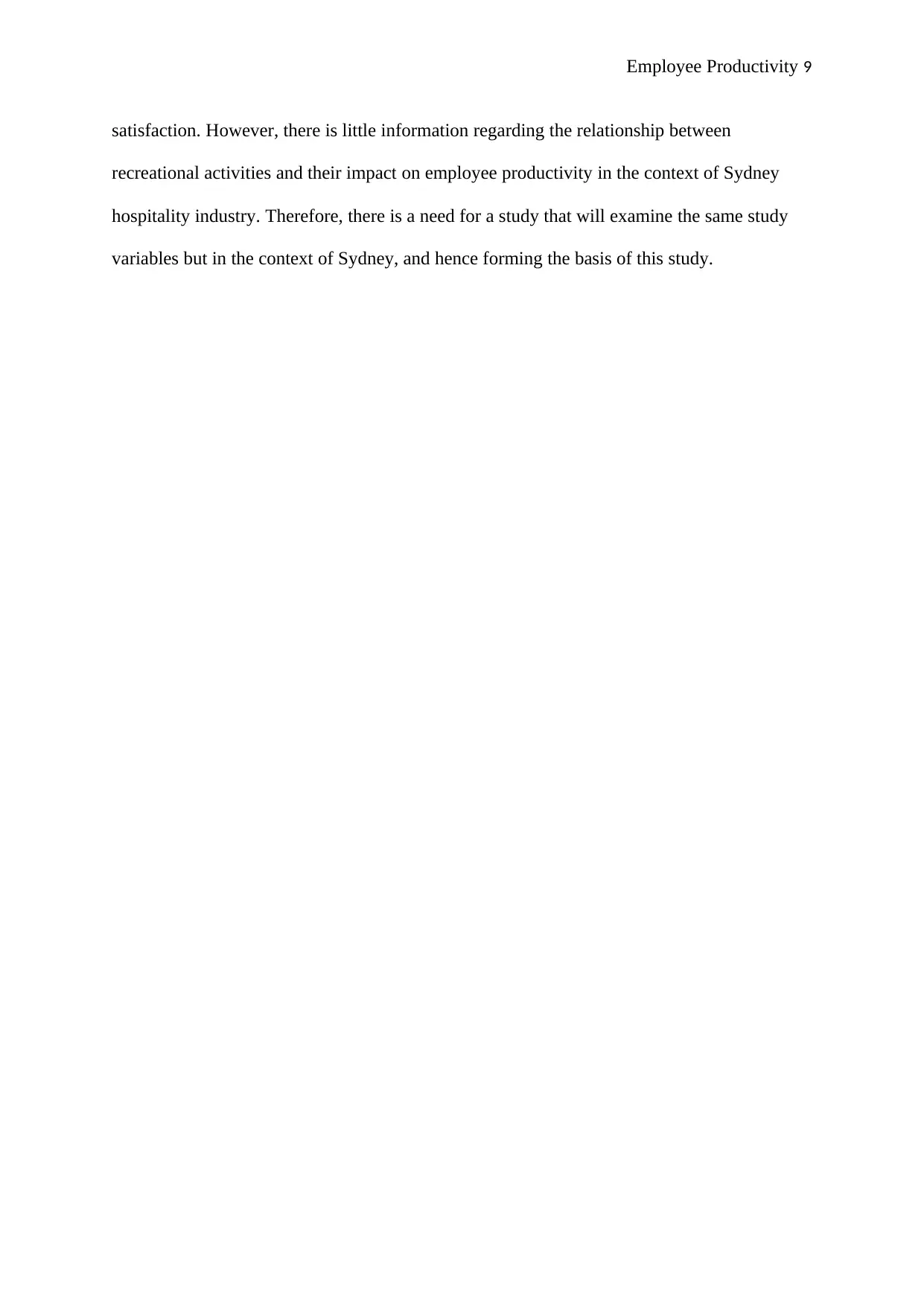
Employee Productivity 9
satisfaction. However, there is little information regarding the relationship between
recreational activities and their impact on employee productivity in the context of Sydney
hospitality industry. Therefore, there is a need for a study that will examine the same study
variables but in the context of Sydney, and hence forming the basis of this study.
satisfaction. However, there is little information regarding the relationship between
recreational activities and their impact on employee productivity in the context of Sydney
hospitality industry. Therefore, there is a need for a study that will examine the same study
variables but in the context of Sydney, and hence forming the basis of this study.
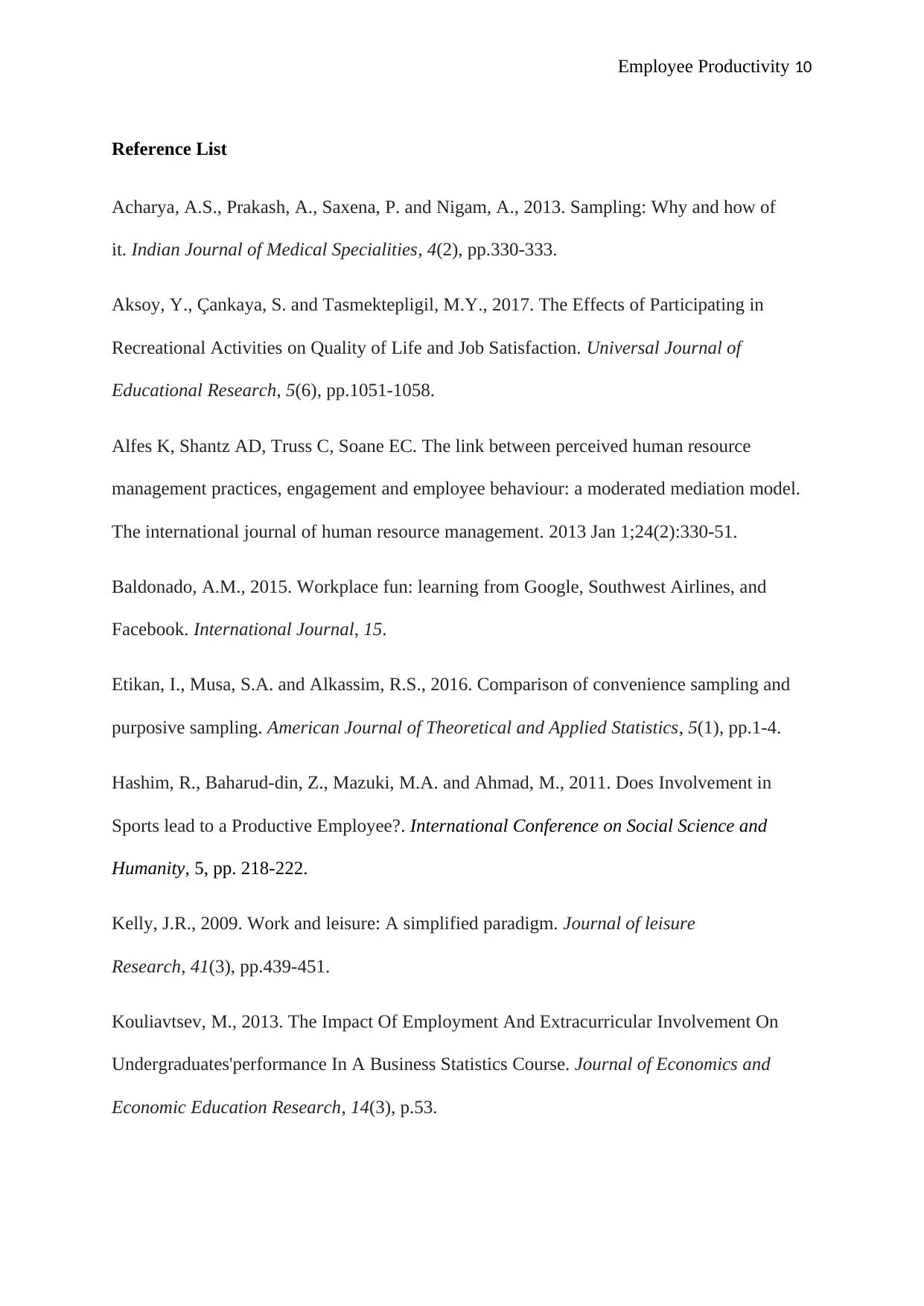
Employee Productivity 10
Reference List
Acharya, A.S., Prakash, A., Saxena, P. and Nigam, A., 2013. Sampling: Why and how of
it. Indian Journal of Medical Specialities, 4(2), pp.330-333.
Aksoy, Y., Çankaya, S. and Tasmektepligil, M.Y., 2017. The Effects of Participating in
Recreational Activities on Quality of Life and Job Satisfaction. Universal Journal of
Educational Research, 5(6), pp.1051-1058.
Alfes K, Shantz AD, Truss C, Soane EC. The link between perceived human resource
management practices, engagement and employee behaviour: a moderated mediation model.
The international journal of human resource management. 2013 Jan 1;24(2):330-51.
Baldonado, A.M., 2015. Workplace fun: learning from Google, Southwest Airlines, and
Facebook. International Journal, 15.
Etikan, I., Musa, S.A. and Alkassim, R.S., 2016. Comparison of convenience sampling and
purposive sampling. American Journal of Theoretical and Applied Statistics, 5(1), pp.1-4.
Hashim, R., Baharud-din, Z., Mazuki, M.A. and Ahmad, M., 2011. Does Involvement in
Sports lead to a Productive Employee?. International Conference on Social Science and
Humanity, 5, pp. 218-222.
Kelly, J.R., 2009. Work and leisure: A simplified paradigm. Journal of leisure
Research, 41(3), pp.439-451.
Kouliavtsev, M., 2013. The Impact Of Employment And Extracurricular Involvement On
Undergraduates'performance In A Business Statistics Course. Journal of Economics and
Economic Education Research, 14(3), p.53.
Reference List
Acharya, A.S., Prakash, A., Saxena, P. and Nigam, A., 2013. Sampling: Why and how of
it. Indian Journal of Medical Specialities, 4(2), pp.330-333.
Aksoy, Y., Çankaya, S. and Tasmektepligil, M.Y., 2017. The Effects of Participating in
Recreational Activities on Quality of Life and Job Satisfaction. Universal Journal of
Educational Research, 5(6), pp.1051-1058.
Alfes K, Shantz AD, Truss C, Soane EC. The link between perceived human resource
management practices, engagement and employee behaviour: a moderated mediation model.
The international journal of human resource management. 2013 Jan 1;24(2):330-51.
Baldonado, A.M., 2015. Workplace fun: learning from Google, Southwest Airlines, and
Facebook. International Journal, 15.
Etikan, I., Musa, S.A. and Alkassim, R.S., 2016. Comparison of convenience sampling and
purposive sampling. American Journal of Theoretical and Applied Statistics, 5(1), pp.1-4.
Hashim, R., Baharud-din, Z., Mazuki, M.A. and Ahmad, M., 2011. Does Involvement in
Sports lead to a Productive Employee?. International Conference on Social Science and
Humanity, 5, pp. 218-222.
Kelly, J.R., 2009. Work and leisure: A simplified paradigm. Journal of leisure
Research, 41(3), pp.439-451.
Kouliavtsev, M., 2013. The Impact Of Employment And Extracurricular Involvement On
Undergraduates'performance In A Business Statistics Course. Journal of Economics and
Economic Education Research, 14(3), p.53.
Secure Best Marks with AI Grader
Need help grading? Try our AI Grader for instant feedback on your assignments.

Employee Productivity 11
Maxwell, J.A., 2012. Qualitative research design: An interactive approach (Vol. 41). Sage
publications.
Mokaya, S. and Gitari, J.W., 2012. Effects of workplace recreation on employee
performance: The case of Kenya Utalii College. International journal of humanities and
social science, 2(3), pp.176-183.
Monteiro, S. and Almeida, L.S., 2015. The relation of career adaptability to work experience,
extracurricular activities, and work transition in Portuguese graduate students. Journal of
Vocational Behavior, 91, pp.106-112.
Mugenda, A.G., 2013. Qualitative research methods: Introduction. Nairobi: Applied
Research & Training Services.
Noble, H. and Smith, J., 2015. Issues of validity and reliability in qualitative
research. Evidence-Based Nursing, pp.ebnurs-2015.
Parvin, M.M. and Kabir, M.N., 2011. Factors affecting employee job satisfaction of
pharmaceutical sector. Australian journal of business and management research, 1(9), p.113.
Rabionet, S.E., 2011. How I Learned to Design and Conduct Semi-Structured Interviews: An
Ongoing and Continuous Journey. Qualitative Report, 16(2), pp.563-566.
Shujat, S. and Ameer, F., 2011. Effects of Recreational and Entertainment Activities on
Employees Job Satisfaction: A Case Study. Journal of Management and Social
Sciences, 7(1), pp.12-18.
Torkildsen, G., 2012. Leisure and recreation management. Routledge.
Turner III, D.W., 2010. Qualitative interview design: A practical guide for novice
investigators. The qualitative report, 15(3), pp.754-760.
Maxwell, J.A., 2012. Qualitative research design: An interactive approach (Vol. 41). Sage
publications.
Mokaya, S. and Gitari, J.W., 2012. Effects of workplace recreation on employee
performance: The case of Kenya Utalii College. International journal of humanities and
social science, 2(3), pp.176-183.
Monteiro, S. and Almeida, L.S., 2015. The relation of career adaptability to work experience,
extracurricular activities, and work transition in Portuguese graduate students. Journal of
Vocational Behavior, 91, pp.106-112.
Mugenda, A.G., 2013. Qualitative research methods: Introduction. Nairobi: Applied
Research & Training Services.
Noble, H. and Smith, J., 2015. Issues of validity and reliability in qualitative
research. Evidence-Based Nursing, pp.ebnurs-2015.
Parvin, M.M. and Kabir, M.N., 2011. Factors affecting employee job satisfaction of
pharmaceutical sector. Australian journal of business and management research, 1(9), p.113.
Rabionet, S.E., 2011. How I Learned to Design and Conduct Semi-Structured Interviews: An
Ongoing and Continuous Journey. Qualitative Report, 16(2), pp.563-566.
Shujat, S. and Ameer, F., 2011. Effects of Recreational and Entertainment Activities on
Employees Job Satisfaction: A Case Study. Journal of Management and Social
Sciences, 7(1), pp.12-18.
Torkildsen, G., 2012. Leisure and recreation management. Routledge.
Turner III, D.W., 2010. Qualitative interview design: A practical guide for novice
investigators. The qualitative report, 15(3), pp.754-760.

Employee Productivity 12
World Health Organization, 2003. Health and Development through Physical Activity and
Sport Journal: Hill, Inc USA Vol. 4. Pp.56-82.
World Health Organization, 2003. Health and Development through Physical Activity and
Sport Journal: Hill, Inc USA Vol. 4. Pp.56-82.
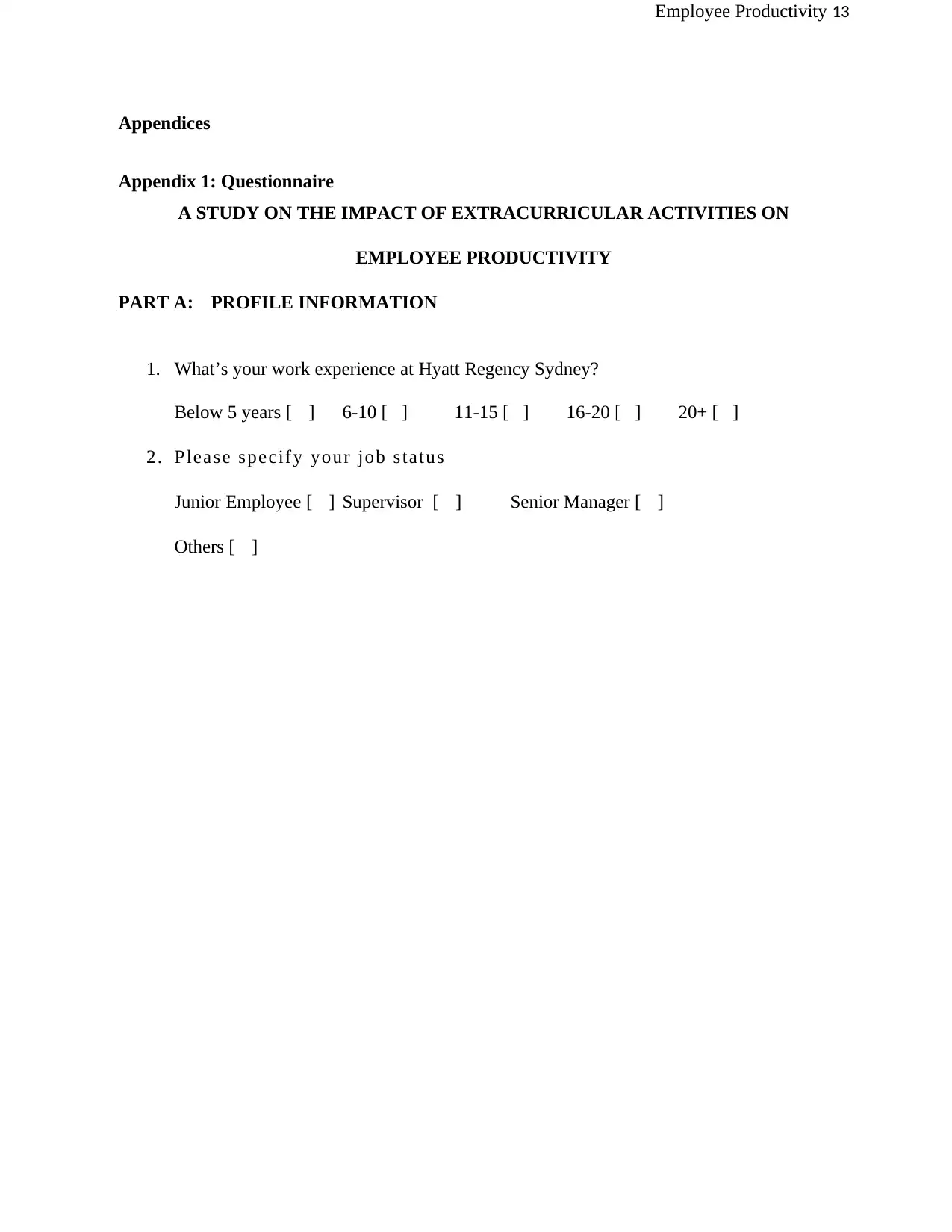
Employee Productivity 13
Appendices
Appendix 1: Questionnaire
A STUDY ON THE IMPACT OF EXTRACURRICULAR ACTIVITIES ON
EMPLOYEE PRODUCTIVITY
PART A: PROFILE INFORMATION
1. What’s your work experience at Hyatt Regency Sydney?
Below 5 years [ ] 6-10 [ ] 11-15 [ ] 16-20 [ ] 20+ [ ]
2. Please specify your job status
Junior Employee [ ] Supervisor [ ] Senior Manager [ ]
Others [ ]
Appendices
Appendix 1: Questionnaire
A STUDY ON THE IMPACT OF EXTRACURRICULAR ACTIVITIES ON
EMPLOYEE PRODUCTIVITY
PART A: PROFILE INFORMATION
1. What’s your work experience at Hyatt Regency Sydney?
Below 5 years [ ] 6-10 [ ] 11-15 [ ] 16-20 [ ] 20+ [ ]
2. Please specify your job status
Junior Employee [ ] Supervisor [ ] Senior Manager [ ]
Others [ ]
Paraphrase This Document
Need a fresh take? Get an instant paraphrase of this document with our AI Paraphraser
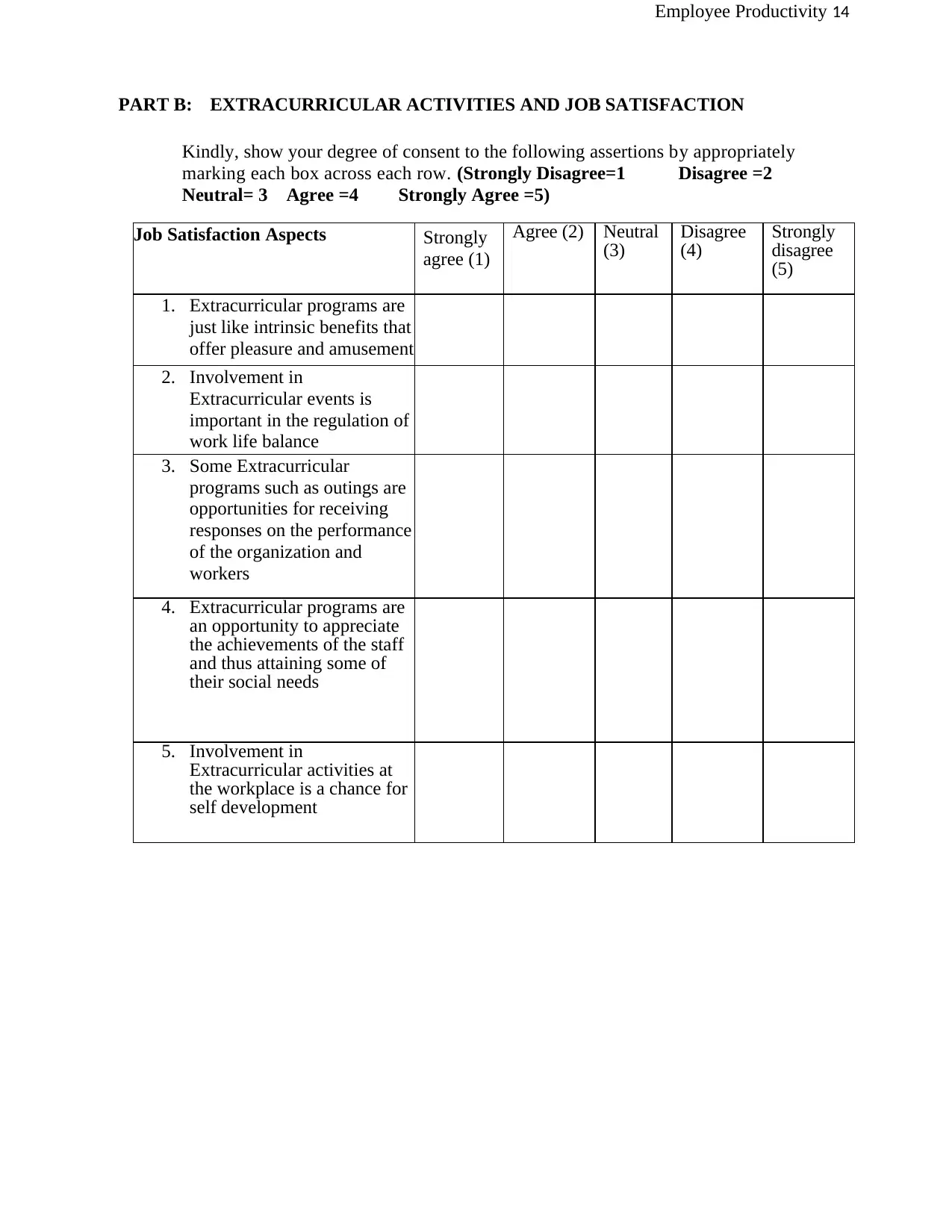
Employee Productivity 14
PART B: EXTRACURRICULAR ACTIVITIES AND JOB SATISFACTION
Kindly, show your degree of consent to the following assertions by appropriately
marking each box across each row. (Strongly Disagree=1 Disagree =2
Neutral= 3 Agree =4 Strongly Agree =5)
Job Satisfaction Aspects Strongly
agree (1)
Agree (2) Neutral
(3) Disagree
(4) Strongly
disagree
(5)
1. Extracurricular programs are
just like intrinsic benefits that
offer pleasure and amusement
2. Involvement in
Extracurricular events is
important in the regulation of
work life balance
3. Some Extracurricular
programs such as outings are
opportunities for receiving
responses on the performance
of the organization and
workers
4. Extracurricular programs are
an opportunity to appreciate
the achievements of the staff
and thus attaining some of
their social needs
5. Involvement in
Extracurricular activities at
the workplace is a chance for
self development
PART B: EXTRACURRICULAR ACTIVITIES AND JOB SATISFACTION
Kindly, show your degree of consent to the following assertions by appropriately
marking each box across each row. (Strongly Disagree=1 Disagree =2
Neutral= 3 Agree =4 Strongly Agree =5)
Job Satisfaction Aspects Strongly
agree (1)
Agree (2) Neutral
(3) Disagree
(4) Strongly
disagree
(5)
1. Extracurricular programs are
just like intrinsic benefits that
offer pleasure and amusement
2. Involvement in
Extracurricular events is
important in the regulation of
work life balance
3. Some Extracurricular
programs such as outings are
opportunities for receiving
responses on the performance
of the organization and
workers
4. Extracurricular programs are
an opportunity to appreciate
the achievements of the staff
and thus attaining some of
their social needs
5. Involvement in
Extracurricular activities at
the workplace is a chance for
self development
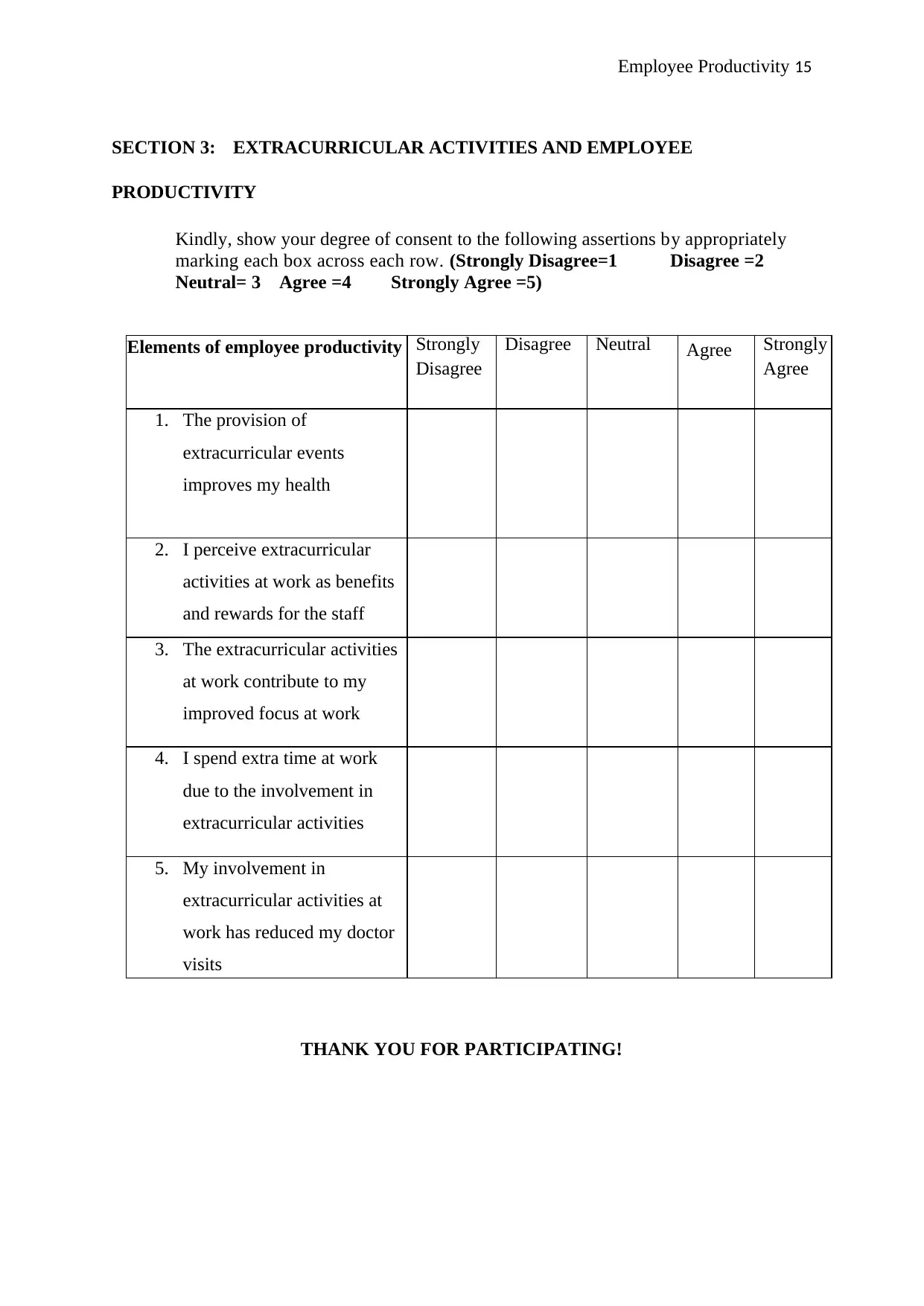
Employee Productivity 15
SECTION 3: EXTRACURRICULAR ACTIVITIES AND EMPLOYEE
PRODUCTIVITY
Kindly, show your degree of consent to the following assertions by appropriately
marking each box across each row. (Strongly Disagree=1 Disagree =2
Neutral= 3 Agree =4 Strongly Agree =5)
Elements of employee productivity Strongly
Disagree
Disagree Neutral Agree Strongly
Agree
1. The provision of
extracurricular events
improves my health
2. I perceive extracurricular
activities at work as benefits
and rewards for the staff
3. The extracurricular activities
at work contribute to my
improved focus at work
4. I spend extra time at work
due to the involvement in
extracurricular activities
5. My involvement in
extracurricular activities at
work has reduced my doctor
visits
THANK YOU FOR PARTICIPATING!
SECTION 3: EXTRACURRICULAR ACTIVITIES AND EMPLOYEE
PRODUCTIVITY
Kindly, show your degree of consent to the following assertions by appropriately
marking each box across each row. (Strongly Disagree=1 Disagree =2
Neutral= 3 Agree =4 Strongly Agree =5)
Elements of employee productivity Strongly
Disagree
Disagree Neutral Agree Strongly
Agree
1. The provision of
extracurricular events
improves my health
2. I perceive extracurricular
activities at work as benefits
and rewards for the staff
3. The extracurricular activities
at work contribute to my
improved focus at work
4. I spend extra time at work
due to the involvement in
extracurricular activities
5. My involvement in
extracurricular activities at
work has reduced my doctor
visits
THANK YOU FOR PARTICIPATING!
1 out of 15
Related Documents
Your All-in-One AI-Powered Toolkit for Academic Success.
+13062052269
info@desklib.com
Available 24*7 on WhatsApp / Email
![[object Object]](/_next/static/media/star-bottom.7253800d.svg)
Unlock your academic potential
© 2024 | Zucol Services PVT LTD | All rights reserved.





